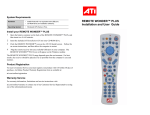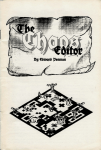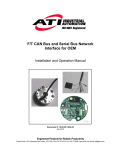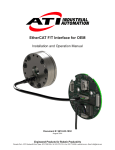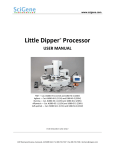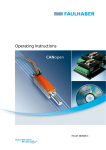Download APPROVAL PAGE FOR GRADUATE THESIS OR PROJECT GS
Transcript
APPROVAL PAGE FOR GRADUATE THESIS OR PROJECT GS-13 SUBMITTED IN PARTIAL FULFILLMENT OF REQUIREMENTS FOR DEGREE OF MASTER OF SCIENCE AT CALIFORNIA STATE UNIVERSITY, LOS ANGELES BY Corey Baker Candidate Electrical and Computer Engineering Department TITLE: DESIGN AND IMPLEMENTATION OF A NON-LINEAR DYNAMICAL SYSTEM REPLICATING SPRING BUCKLING BEHAVIOR APPROVED: Deborah Won Faculty Member-CSULA Signature Kamran Karimlou Faculty Member-CSULA Signature Fred Daneshgaran Faculty Member-CSULA Signature Fred Daneshgaran Department Chairperson Signature DATE: June 17, 2010 DESIGN AND IMPLEMENTATION OF A NON-LINEAR DYNAMICAL SYSTEM REPLICATING SPRING BUCKLING BEHAVIOR A Thesis Presented to The Faculty of the Department of Electrical and Computer Engineering California State University, Los Angeles In Partial Fulfillment of the Requirements for the Degree Master of Science By Corey Baker June 2010 c 2010 Corey Baker ALL RIGHTS RESERVED ii ACKNOWLEDGMENTS I would like thank Francisco Valero-Cuevas and his Brain and Body Dynamics Lab at the University of Southern California for allowing me to work in their lab, providing me with the supplies needed, and guiding me in the project. Without the help of all of you my work would have not been completed. iii ABSTRACT Design and implementation of a non-linear dynamical system replicating spring buckling behavior By Corey Baker A device was designed and implemented to replicate spring buckling using a linear motor. The device was designed using an off the shelf motor, microcontroller, DAQ, and force transducer. Once the device was put together a program was written in matlab to control the motor. Tests were done to replicate a spring damper system and once this system was realized, tests were done to replicate the Duffing oscillater that exhibits subcritical pitchfork bifurcation. The finished device can be used to investigate how vision and tactile integration play a role in dynamic manipulation. iv TABLE OF CONTENTS Acknowledgments . . . . . . . . . . . . . . . . . . . . . . . . . . . . . . . . . iii . . . . . . . . . . . . . . . . . . . . . . . . . . . . . . . . . . . . . . iv List of Figures . . . . . . . . . . . . . . . . . . . . . . . . . . . . . . . . . . . viii Abstract 1 Introduction . . . . . . . . . . . . . . . . . . . . . . . . . . . . . . . . . . 1 2 Methods and Design . . . . . . . . . . . . . . . . . . . . . . . . . . . . . . 5 2.1 Linear System . . . . . . . . . . . . . . . . . . . . . . . . . . . . . . . 6 2.1.1 Spring and Damper Equation . . . . . . . . . . . . . . . . . . 6 Non-Linear System . . . . . . . . . . . . . . . . . . . . . . . . . . . . 8 2.2.1 Duffing Oscillator . . . . . . . . . . . . . . . . . . . . . . . . . 8 2.3 Euler Integration . . . . . . . . . . . . . . . . . . . . . . . . . . . . . 12 2.4 Hardware . . . . . . . . . . . . . . . . . . . . . . . . . . . . . . . . . 14 2.4.1 National Instruments Data Acquisition Board . . . . . . . . . 14 2.4.2 Linear Motor and Microcontroller . . . . . . . . . . . . . . . . 15 2.4.3 Force Transducer . . . . . . . . . . . . . . . . . . . . . . . . . 17 2.4.4 Nano17 Transducer Holder . . . . . . . . . . . . . . . . . . . . 18 2.4.5 Linear Motor Holder . . . . . . . . . . . . . . . . . . . . . . . 18 2.2 v 2.5 Software . . . . . . . . . . . . . . . . . . . . . . . . . . . . . . . . . . 19 2.5.1 spring const Function . . . . . . . . . . . . . . . . . . . . . . . 20 2.5.2 spring Function . . . . . . . . . . . . . . . . . . . . . . . . . . 23 2.5.3 propagate Function . . . . . . . . . . . . . . . . . . . . . . . . 26 2.5.4 open serial Function . . . . . . . . . . . . . . . . . . . . . . . 27 2.5.5 wrc serial Function . . . . . . . . . . . . . . . . . . . . . . . . 29 . . . . . . . . . . . . . . . . . . . . . . . . . . . . . . . . . . . . . 32 3.1 Spring and Damper Equation . . . . . . . . . . . . . . . . . . . . . . 32 3.2 Duffing Oscilator . . . . . . . . . . . . . . . . . . . . . . . . . . . . . 35 3 Results 4 Instruction Manual . . . . . . . . . . . . . . . . . . . . . . . . . . . . . . 39 4.1 Initial Setup . . . . . . . . . . . . . . . . . . . . . . . . . . . . . . . . 39 4.2 Code Modification . . . . . . . . . . . . . . . . . . . . . . . . . . . . 40 4.3 Running the Program . . . . . . . . . . . . . . . . . . . . . . . . . . . 42 References . . . . . . . . . . . . . . . . . . . . . . . . . . . . . . . . . . . . . vi 44 LIST OF FIGURES 1.1 Schematic of original experimental setup (1) . . . . . . . . . . . . . . 2 2.1 Designed System . . . . . . . . . . . . . . . . . . . . . . . . . . . . . 5 2.2 Simulated Spring Response . . . . . . . . . . . . . . . . . . . . . . . . 7 2.3 Potential Energy . . . . . . . . . . . . . . . . . . . . . . . . . . . . . 8 2.4 Potential Energy . . . . . . . . . . . . . . . . . . . . . . . . . . . . . 10 2.5 Subcritical Bifurcation, β > 0 and α < 0 . . . . . . . . . . . . . . . . 11 2.6 Subcritical Bifurcation Phase Portrait, β > 0 and α < 0 . . . . . . . . 12 2.7 Complete Hardware Block Diagram . . . . . . . . . . . . . . . . . . . 14 2.8 MCLM 3006 Circuit Design(2) . . . . . . . . . . . . . . . . . . . . . . 17 2.9 Nano17 Transducer Holder . . . . . . . . . . . . . . . . . . . . . . . . 18 2.10 Linear Motor Holder . . . . . . . . . . . . . . . . . . . . . . . . . . . 19 2.11 motor cntrl Function Block Diagram . . . . . . . . . . . . . . . . . . 20 2.12 spring const Function State Diagram . . . . . . . . . . . . . . . . . . 22 2.13 spring Function State Diagram . . . . . . . . . . . . . . . . . . . . . 25 2.14 propagate Function State Diagram . . . . . . . . . . . . . . . . . . . . 27 2.15 open serial Function State Diagram . . . . . . . . . . . . . . . . . . . 28 2.16 wrc serial Function State Diagram . . . . . . . . . . . . . . . . . . . 31 vii 3.1 Comparison of Motor Response to Simulated Response k = 95, δ = 10 3.2 Comparison of Motor Response to Simulated Response k = 295, δ = 10 34 3.3 Stable Motor Response β = 314, α = 3140000, δ = 10 . . . . . . . . . 36 3.4 Stable Motor Response β = 314, α = 3140000, δ = 10 . . . . . . . . . 36 3.5 Unstable Motor Response β = 314, α = 3140000, δ = 10 . . . . . . . . 37 3.6 Unstable Motor Response β = 314, α = 3140000, δ = 10 . . . . . . . . 37 viii 33 Chapter 1 INTRODUCTION The nervous system is key to integrating and managing dynamic sensorimotor information. Understanding neural control can be complicated because the intricate behavior is non-linear and highly dimensional (3). Grasping objects with the fingers and thumb is a simple task that humans perform daily. Vision is often not needed to grasp an object, but when sensory feedback such as feeling in fingers is absent, vision is more relied upon (1). Force vectors applied by the fingers on an object must be of sufficient magnitude to prevent slipping in the presence of gravity and other external loads (4). Identifying how vision assists in grasping objects along with identifying timedelays can aid in clinical efforts. To see how vision and time-delays play a role, experiments where done and the results are in the paper, Manipulating the edge of instability (1). Results from bifurcation theory suggests that many nonlinear dynamical systems exhibit low-dimensional dynamics at the edge of of instability (5). Based on the center manifold theorem, a low dimensional form on a center manifold can represent the dynamics of high-dimentional systems at the edge of instability (5). In the paper, the thumbpad was used to compress a slender spring as far as possible 1 just before slipping. This brought the thumb+spring+nervous system to the edge of instability (1). The experiments were done on 12 consenting young adults (9 male, 3 female), who were all right handed and had no recent hand impairments. All subjects had no prior experience with the experimental setup. The experimental setup looks like the figure below: Figure 1.1: Schematic of original experimental setup (1) Subjects wrapped their fingers around the vertical post and placed their thumbpad on top of the endcap in Figure 1.1. The bottom of the spring rests on a force transducer that logged force at 1000Hz. The motion capture cameras captured the 3D location and orientation of the reflective markers at 200Hz using a 4-camera motion capture system. The palm of the hand never touched the spring or the vertical 2 post and the subject can view the setup from any angle of their choosing. Feedback was provided using an audible 500Hz tone that linearly decreased in volume as the vertical compressive spring force increased (1). The subjects were instructed to slowly compress the spring using only their thumpad to make the tone volume as faint as possible without letting the spring slip. Once this point was reached, the subjects needed to maintain this load force (hear a constant tone) for 10s without letting the spring slip and then slowly release the spring. It did not matter if the spring oscillated or bent, but that the volume remained constant and the spring did not slip (1). Experiments were performed over two days. Day 1 was a training day, used for acclimating the subjects to the system. During this day, the subjects performed 100 compressions and the performance was measured before and after the training. On day 2, the performance of the subject was measured using normal thumbpad sensibility, both with and without vision. Thumbpad sensibility was then reduced when a hand surgeon administered 5 cc of 1% Lidocaine solution on the ulnar and radial sides of the base of the thumb (just below the metacarpophalangeal (MCP) joint of the thumb, but away from the thenar eminence) to obtain a digital nerve-block without affecting any musculature (and associated sensors) (1). In order to perform experiments like the one mentioned above, the spring will be taken out of the system and replaced by a linear motor. If successful, the device 3 developed should provide us with a different set of testing abilities since we can manipulate the edge of instability with a known low dimensional non-linear dynamical system. The system of choice will be the Duffing oscillator which is known to model chaotic behavior depending on the parameters chosen. If configured correctly, the Duffing oscilator could resemble the subcritical pitchfork bifurcation(6) that models spring buckling as seen in the paper Manipulating the edge of instability (1). 4 Chapter 2 METHODS AND DESIGN In order to design the system, off the shelf components such as: a linear motor, data acquisition board, and a force transducer will be needed to make the new device used to manipulate the edge of stability. Also, parts designed in solid works such as: a transducer holder, and linear motor holder are designed to help combine all of the devices together. Before making the motor behave like a non-linear system, we first attempt a linear case using the Spring and Damper Equation. After implementing and testing the linear case, we move on to a non-linear system using the Duffing oscillator. The designed system setup is pictured below: (a) Complete View (b) Top View Figure 2.1: Designed System 5 2.1 Linear System 2.1.1 Spring and Damper Equation Hooke’s Law of elasticity is known to approximate the extension of a spring. The variables used in Hooke’s Law in terms of our application are below: • Fmotor - restoring force of the motor • x - displacement of the motor • k - spring constant The equation is below: Fmotor = −kx (2.1) To approximate an oscillating spring whose oscillations reduce due to friction, we add damping to the equation above. The following variables are added: • c - damping coefficient • ẋ - velocity The equation turns into: Fmotor = −kx − cẋ 6 (2.2) Using Newton’s second law of motion, F = mẍ on the left side of the equation and adding a forcing input, I on the right side, the equation becomes: mẍ = −kx − cẋ + I ẍ = = − k c x − ẋ + I m m (2.3) The simulated response to an initial displacement of 0.03m, k = 1N/m, c = 0.5, I = 0 is below: Response to Initial Conditions 0.03 0.025 0.02 Displacement (m) 0.015 0.01 0.005 0 −0.005 −0.01 −0.015 0 5 10 15 20 25 Time (sec) Figure 2.2: Simulated Spring Response The potential energy can be determined from equation 2.3 by putting all terms on the left hand side and having no forcing input, I = 0 and integrating equation. 7 The potential energy equation is below: 1 1 E(t) = δ ẋ2 + kx2 2 2 (2.4) The graph of the potential energy when δ = 0, k > 0 is pictured below: Potential Energy 0.06 0.05 Energy 0.04 0.03 0.02 0.01 0 −0.04 −0.03 −0.02 −0.01 0 0.01 Displacement(m) 0.02 0.03 0.04 Figure 2.3: Potential Energy 2.2 2.2.1 Non-Linear System Duffing Oscillator The linear motor is meant to replace the spring in the experimental setup and bring the system to the edge of instability by replicating spring buckling. The Duffing oscillator is a dynamical non-linear system that is known to model chaotic behavior(7). The system will model different behaviors depending on the variables below: 8 • δ - damping constant • β - spring constant • α - duffing constant • γ - forcing constant • ω - angle • φ - phase angle The Duffing equation is a non-linear second-order equation is seen below: ẍ + δ ẋ + βx + αx3 = γ cos(ωt + φ) (2.5) The Duffing Oscillator can take on different behaviors, for instance changing β from positive to negative gives a supercritical pitchfork bifurcation. If β > 0 the restoring force is Fmotor = −βx − αx3 − αẋ (2.6) When α > 0 and for small values of x, equation 2.7 is a hardening spring and when α < 0 the equation is a softening spring (8). The case when β < 0 creates a double well potential (6). The restoring force then becomes: Fmotor = βx − αx3 − αẋ 9 (2.7) The potential energy when there is no forcing (γ = 0) can be found for the oscillator by integrating equation 2.5. The solution is below: 1 1 1 E(t) = δ ẋ2 + βx2 + αx4 2 2 4 (2.8) The potential energy graph is pictured below: Potential Energy 0.14 Potential Energy 0.02 0.12 0.015 0.1 Energy Energy 0.01 0.08 0.06 0 0.04 −0.005 0.02 0 −0.04 0.005 −0.03 −0.02 −0.01 0 0.01 Displacement (m) 0.02 0.03 −0.01 −0.04 0.04 (a) β > 0, δ = 0, α < 0 −0.03 −0.02 −0.01 0 0.01 Displacement (m) 0.02 0.03 0.04 (b) β < 0, δ = 0, α < 0 Figure 2.4: Potential Energy In order to manipulate the edge of instability, a subcritical pitchfork bifurcation needs to be replicated. This done by changing β and α so that Figure 2.4(b) is inverted. The graph of the subcritical bifurcation is pictured below: 10 Potential Energy 0.01 0.005 Energy 0 −0.005 −0.01 −0.015 −0.02 −0.04 −0.03 −0.02 −0.01 0 0.01 Displacement (m) 0.02 0.03 0.04 Figure 2.5: Subcritical Bifurcation, β > 0 and α < 0 There will always be an equilibrium point at (0, 0). To calculate the other two equilibrium points, the equation below is used: r x=± β α (2.9) The phase portrait for the subcritical pitchfork bifurcation created using pplane8 which was designed by John C. Polking at Rice University. The phase portrait is pictured below: 11 x’=y y ’ = − (k x + c y + l x3)/m −0.1 −0.08 k = 95 m=1 −0.06 −0.04 −0.02 0 x 0.02 0.04 0.06 c = 10 l = − 237500 0.08 0.1 Figure 2.6: Subcritical Bifurcation Phase Portrait, β > 0 and α < 0 The phase portrait shows the displacement versus the velocity. The middle point is asymptotically stable and the points to the left and right are unstable which will drive the system to positive or negative infinity. This phase portrait is used to see how the system should behave. 2.3 Euler Integration In order to handle linear and non-linear functions and calculate the the future displacement, velocity, and acceleration for the motor, the acceleration is integrated over a small interval, τ = ∆t. The acceleration is calculated by using the linear or nonlinear function of choice and using the force along the rod as the input force. The 12 current displacement and velocity are also used. See variables below: • xt - current displacement • ẋt - current velocity • Ft - current force applied along the rod of the motor • xt+τ - future displacement • ẋt+τ - future velocity • ẍt+τ - future velocity • f (xt , ẋt , Ft ) - the linear or nonlinear function So the future acceleration is: ẍt+τ = f (xt , ẋt , Ft ) (2.10) The future velocity is: Z t+τ xt+τ ˙ = ẋt + ẍt dt t = ẋt + τ ẍt (2.11) The future displacement is: Z xt+τ = xt + 2τ ẋt+τ dt 0 = xt + 2τ ẋt+τ + 2τ 2 ẍt+τ 13 (2.12) 2.4 Hardware Multiple devices come together together to make the complete design. The block diagram is below: Nano 17 Signal Conditioner Nano17 Microcontroller LM1247-080-01 NIDAQ PC RS232 Figure 2.7: Complete Hardware Block Diagram 2.4.1 National Instruments Data Acquisition Board The data acquisition board used is the National Instruments NI-PCI-6025E. This board has 16 analog inputs at up to 200kS/s at 12 or 16-bit resolution(9). It also has up to 2 analog outputs at 10kS/s at 12 or 16 bit(9). The analog inputs of the NI-PCI-6025E will be used to power and read the force values from the Nano17. One analog output is used to control the position of the linear motor. For the application 14 in this thesis, matlab will be used to control all DAQ operations. 2.4.2 Linear Motor and Microcontroller The linear dc motor used to for the S-D test is the Faulhaber Quickshaft LM 1247080-01 and is displayed below: The Quickshaft LM1247-080-01 provides us with no residual static force and an excellent relationship between linear force and current. The motor also has built-in Hall sensors which allow position control (10). The MCLM 3006 S is provides precise positioning and very low speeds because it contains a high performance digital signal processor (DSP). The microcontroller will allow the following (10): • Velocity control • Velocity profiles • Positioning mode • Stepper motor mode • Analog positioning mode • Force control Analog Position Control is utilized to control the linear motor. Initial settings as well query commands for getting the current position of the motor are sent over 15 RS232 communication. The maximum baudrate the microcontroller can be set to is 115 kBaud, but 56 kbaud was the highest baudrate the motor was able to operate properly at. The maximum force the motor can exert is 9.36N and can deliver this force for 2 seconds or until the motor reaches a temperature cut-off. After this, the motor drops down to a maximum continuous force of 3.13N and doesn’t go over this force until the temperature drops below the cut-off temperature. The maximum speed and acceleration the motor can provide are 2.71 m/s and 91.57 m/s2 respectively. Variables that are used to calculate various equations for the motor are: • Force constant - kF • Continuous current - Ie • Peak current - Ip The equations used to calculate the force of the motor at any given time are: • Constant force Fe,max = kF Ie,max (2.13) Fp,max = kF Ip,max (2.14) • Peak force The circuit design for the microcontroller is below: 16 Figure 2.8: MCLM 3006 Circuit Design(2) 2.4.3 Force Transducer To interpret the force a patient is exerting on the linear motor, an ATI Nano17 force transducer is used. Force is detected and fed back into a data acquisition board and used as in input for the linear or non-linear equation. The Nano17 measures force in the x,y, and z directions. This allows not only the vertical force of a patient to be measured, but also the force along the rod of the linear motor. The maximum force the Nano17 can endure in the x,y, and z directions are 25N, 25N, and 35N 17 respectively(11). The transducer can also measure torque in the x,y and z directions, but this is not being used at the moment. 2.4.4 Nano17 Transducer Holder A custom device was designed in Solid Works and printed to hold the Nano17 to the linear motor. The device had to be made to both the specifications of the linear motor and the force transducer. The printed device is pictured below: Figure 2.9: Nano17 Transducer Holder 2.4.5 Linear Motor Holder A custom holder needed to be designed in order to holster the linear motor. This holder needed to fit the specifications of the linear motor and also needed to provide stability since the user will be applying different forces to the linear motor. The holder is made out of aluminum and is screwed into another aluminum device, which will 18 be strapped down to a table. The holder is versatile and allows various adjustments of the linear motor to provide comfort for the user. The initial design of the linear motor holder is pictured below: Figure 2.10: Linear Motor Holder 2.5 Software Code was written in Matlab, C, and C++ to control all tasks of the device will perform. The matlab code controls the NIDAQ board which has inputs and outputs to the Nano17 and microcontroller. The C and C++ code is only used for controlling the serial communication. A state machine showing how the motor cntrl function works is below: 19 Setup DAQ/Configure Motor While current_time < stop_time No Yes Get force from Load Cell Set default values for the motor Call spring constant function Plot all saved values Call spring function Turn off motor and force transducer Set force of the motor Set displacement of motor Get displacement of motor Save all values Figure 2.11: motor cntrl Function Block Diagram The motor cntrl functions makes calls to many other Matlab, C and C++ functions. These functions are described in the following sections. 2.5.1 spring const Function This function sets the spring constant variable for the linear or non-linear function. It has three inputs which are: spr const type, xy force, z force, and outputs the spring 20 constant to be used, k. The variable meanings are defined below: • spr const type - string that will dictate how the spring constant is calculated • xy force - horizontal force that is applied in the direction of the rod • z force - vertical force applied • k - the spring constant value that will be outputted It works by first setting a default value to k const. The function checks spr const type to see whether its’ value is “const” or “zforce”. If spr const type is “const”, then k is set to k const. If spr const type is “zforce” then k becomes the product of k const and z force. If spr const type is any other value, the function issues an error. The block diagram for spring const is pictured below: 21 Initial State k_const = const spr_const_type Constant State k = k_const Z Force State k = k_const*z_force Output k Figure 2.12: spring const Function State Diagram The pseudo code for spring const is below: [k] = spring_const(spr_const_type,xy_force,z_force) k_const = const switch(spr_const_type) const: k = k_const zforce: k = k_const*z_force otherwise: error, unrecognized spring constant type The xy force input variable is not used in the block diagram or the pseudo code. This is because it currently has no affect on the spring constant, but this feature can be added at a later date. 22 2.5.2 spring Function This function determines what type of spring equation to use and makes calls to calculate the future displacement, velocity, and acceleration. The function spring has the following inputs: spr eq, m, k, x, v, f, t del. The outputs are: acc, x fut, and v fut. These variables are defined below: • spr eq - string that will dictate which equation will be used to calculate the future acceleration, future displacement, and future velocity. • m - mass of the system • k - spring constant • c - damping coefficient • x - current displacement • v - current velocity • δ - damping constant • α - duffing constant • γ - current horizontal force applied to the system • ω - angle 23 • φ - phase angle • t del - current time delay • acc - future acceleration • x fut - future displacement • v fut - future velocity The function works by checking to see if spr eq equals “lin damp” or “non lin damp”. If spr eq equals “lin damp”, it sets the damping coefficient c to a constant value, calculates the future acceleration using k, m, c, v, and f, and plugging them into the linear spring damper equation 2.3. If spr eq equals “non lin damp”, it sets the damping coefficient c to a constant value, calculates the current acceleration using δ, β, α, γ, ω, φ, c, v, and f and plugging them into equation (2.5). If spr eq is any other value, the function issues an error. The block diagram for spring is pictured below: 24 spr_eq Linear Damping State acc = -(k/m)*x - (c/m}*v + (1/m)*f Non-Linear Damping State acc = -omega_not^2 -alpha*x^3 - delta*v + gamma*cos(ft+phi) Propogat State Call propagate function Output acc, x_future, v_future Figure 2.13: spring Function State Diagram The pseudo code for the spring function is below: [acc,x_fut,v_fut] = spring(spr_eq,m,k,x,v,f,t_del) switch(spr_eq) lin_damp: c= 10 acc = -(k/m) - (c/m)*v + (1/m)*f call propagate function duffing: will be implemented later otherwise: error, unrecognized spring constant type 25 2.5.3 propagate Function The propagate Function calculates the future displacement and velocity based off of the the current displacement, current velocity, future acceleration, and time delay of the last time the loop was implemented. The inputs are: acc calc, x val, v val, delta t. The outputs arex next and v next. The variables are defined below: • acc calc - future acceleration • x val - current displacement • v val - current velocity • delta t - current time delay • x next - future displacement • v next - future velocity The function works by implementing the integration equations mentioned in section 2.3. First the equation multiplies delta t by acc calc and adds it to v val based off of equation 2.11 to get v next. Then the function multiplies 2 by delta t and v val adds it to 2 multiplied by delta t 2 and acc calc and adds that to x val to get x val based off of equation 2.12. The state machine is pictured below: 26 V Next State v_next = v_val + delta_t*acc_calc X Next State x_next = x_val + 2*delta_t*v_val + 2*dela_t^2) Output x_next,v_next Figure 2.14: propagate Function State Diagram The pseudo code for the spring function is below: [x_next,v_next] = propagate(acc_calc,x_val,v_val, delta_t) v_next = v_val + delta_t*acc_calc x_next = x_val + 2*delta_t*v_val+ 2*(delta_t^2)*acc_calc 2.5.4 open serial Function The open serial Function is one of the two MEX functions created. The function is responsible for opening and configuring the serial port. The open serial Function has no inputs and one output, output[0]. The MEX file for this function also has one additional sub-function named SerialInit that has one input, BaudRate and returns the serial object. The variables are defined below: 27 • output[0] - the address of the serial port. • BaudRate - baudrate used to open the serial port. The function works by calling the SerialInit function which opens the serial port with the BaudRate passed to it by open serial. Once the serial port is opened properly, the function exits outputing the address of the open serial port object. The state machine is below: Initial State Declare all needed variables and call SerialInit Open Port State Open Serial Port 5 Has the port opened properly? No Error State Issue open port error Yes Set Port Parameters State Set default parameters Error State Issue config port error No Able to set parameters? Yes Output Serial Port Address Figure 2.15: open serial Function State Diagram 28 2.5.5 wrc serial Function The wrc serial Function is the last of the MEX function created. The function writes to, reads from, and configures the linear motor. All of the commands are sent to and received from the microcontroller of the linear motor. The function is very versatile because the inputs and outputs of the function change based off of its’ second parameter. The wrc serial takes a minimum of two inputs and does not need to output data. The first parameter is always the address of the serial port object. The second parameter is always an integer value from “1” to “4” that tells the function how to behave. Every case below uses the first parameter to read or write to the serial port, so the use of the first parameter will be omitted for the rest of the discussion. When every case below is entered, the function checks to make sure the right amount of inputs and outputs have been passed to the function before it proceeds. If the wrong amounts of inputs or outputs are passed, the function issues an error and exits. The input and output checking is omitted from below but is seen in the function state machine. If the second parameter is “1”, the function needs two inputs and no outputs. The second parameter value of “1” is used to configure the motor by calling the subfunction ConfigMotor. The ConfigMotor calls another subfunction SerialWrite to write all the configuration values to the motor. If the second parameter is “2”, the function needs two inputs and one output. The 29 second parameter value of “2” is used to set the position of the motor by using the SerialWrite function to write the get position command, “POS” to the linear motor and then using the SerialRead subfunction to receive the position value of the motor. If the second parameter is “3”, the function has four inputs and no outputs. The second parameter value of “3” sets the peak and continuous force of the motor using the values of the third and fourth input parameters respectively. This is done by calling the subfunction SerialWrite to write each value to the motor. If the second parameter is “4”, the function has two inputs and no outputs. The second parameter value of “4” is used to turn off the motor. The second parameter value of “4” uses SerialWrite subfunction to send the disable command, “DI” to the motor. After the motor has been disabled, the wrc serial Function calls the subfunction CloseHandle to close the serial port. The state machine for the wrc serial Function is pictured below: 30 Initial State Declare all needed variables Has the minimum inputs and outputs been passed? Error State Issue open port error No Yes Get Inputs State Get the first and second input 1 Configure Motor State Call ConfigMotor function Get Motor Position State No Check Second Parameter 2 Has the correct amount of inputs and outputs been passed? 3 4 Set Motor Force State Has the correct amount of inputs and outputs been passed? Disable State Call SerialWrite using "DI" is second input No Error State Issue open port error Error State Issue open port error Yes Yes Want Position State Call SerialWrite using "POS" is second input Write Peak Force State Call SerialWrite using "LPC parameter3" is second input Read Position State Write Continuos Force State Call SerialWrite using "LCC parameter4" is second input Output output position Figure 2.16: wrc serial Function State Diagram 31 Chapter 3 RESULTS Once the design of the system and program was completed, tests were done to obtain behavior that mimicked the spring and damper system and the Duffing oscillator. All of the results shown have the forcing input set to 0. 3.1 Spring and Damper Equation To test whether the linear motor behaved like a spring that produced the correct amount of restoring force for the appropriate displacement, the following calculation was done to compute the spring constant when no velocity is present: k= Fe,motor xmaxdisplacement 3.13N k= 0.033m k ∼ 95 (3.1) Using the spring constant above, tests out the max force of the motor at the max displacements. It also gives us a starting point to increase the spring constant if a harder spring needs to be replicated. The results for the motor displacements, 32 simulated displacements, and force delivered are pictured below: 0.01 0.005 Response to Initial Conditions 0.005 Target Position Actual Position 0 0 Displacement (m) Distance m −0.005 −0.005 −0.01 −0.01 −0.015 −0.015 −0.02 −0.02 −0.025 0 0.2 0.4 0.6 0.8 1 time s 1.2 1.4 1.6 1.8 −0.025 2 0 0.2 0.4 0.6 0.8 1 1.2 Time (sec) (a) Motor displacement (b) Simulated motor displacement 2.5 Peak Force Continuous Force 2 1.5 Fmotor N 1 0.5 0 −0.5 −1 −1.5 −2 0 0.2 0.4 0.6 0.8 1 time 1.2 1.4 1.6 1.8 2 (c) Motor Force k = 95, δ = 10 Figure 3.1: Comparison of Motor Response to Simulated Response k = 95, δ = 10 33 0.025 0.005 0.015 0 Displacement (m) 0.01 Distance m Response to Initial Conditions 0.01 Target Position Actual Position 0.02 0.005 0 −0.005 −0.01 −0.005 −0.01 −0.015 −0.015 −0.02 −0.02 −0.025 0 −0.025 0.2 0.4 0.6 0.8 1 time s 1.2 1.4 1.6 1.8 2 0 0.2 0.4 0.6 0.8 1 1.2 Time (sec) (a) Motor displacement (b) Simulated motor displacement 8 Peak Force Continuous Force 6 4 Fmotor N 2 0 −2 −4 −6 −8 −10 0 0.2 0.4 0.6 0.8 1 time 1.2 1.4 1.6 1.8 2 (c) Motor Force Figure 3.2: Comparison of Motor Response to Simulated Response k = 295, δ = 10 In both of the figures, the initial displacement was −0.024m and the initial velocity was 0m/s. The motor response and the simulated response were similar for the two test trials above. A closer response to the simulated response can be realized by adjusting the PID in the linear motor. For these test cases and the ones to follow, the PID values were set to default values. When considering the motor force plots, 34 Figures 3.1(c) and 3.2(c), is the minimum value of the continuous force oscillates from −1N to 1N . This is because 1N is the lowest force the motor would respond correctly at when told to move to a given displacement. Also note that the motor always applies the continuous force and applies the peak force only if the force in the opposing direction is greater than the continuos force. 3.2 Duffing Oscilator After the linear spring could be realized by the motor, the next step was to replicate the Duffing oscillator that exhibits subcritical bifurcation. The details on the potential energy graphs are found in section 2.2.1. The spring constant, β was calculated using equation 3.1. The x value in the equation was changed to 0.01 because the desired equilibrium points were set to (−0.01m, 0), (0m, 0).(0.01m, 0). The α value was then calculated using equation 2.9. The results for the motor displacements and forces for different initial displacements are pictured below: 35 −3 x 10 10 2 Target Position Actual Position Peak Force Continuous Force 1.5 1 Fmotor N Distance m 5 0.5 0 0 −0.5 −1 −5 0 0.2 0.4 0.6 0.8 1 time s 1.2 1.4 1.6 1.8 −1.5 0 2 0.2 0.4 (a) Motor displacement 0.6 0.8 1 time 1.2 1.4 1.6 1.8 2 (b) Motor Force Figure 3.3: Stable Motor Response β = 314, α = 3140000, δ = 10 −3 5 x 10 1 Peak Force Continuous Force Target Position Actual Position 0.5 0 Fmotor N Distance m 0 −5 −0.5 −1 −1.5 −10 0 0.2 0.4 0.6 0.8 1 time s 1.2 1.4 1.6 1.8 −2 0 2 (a) Motor displacement 0.2 0.4 0.6 0.8 1 time 1.2 1.4 1.6 1.8 2 (b) Motor Force Figure 3.4: Stable Motor Response β = 314, α = 3140000, δ = 10 In Figure 3.3, the initial displacement was 0.009m and the initial velocity of 0m/s. In Figure 3.4 the initial displacement was 0.009m and the initial velocity of 0m/s. The system stayed stable and decreased with an exponential oscillation to the equilibrium 36 point (0, 0). The behavior was similar to a spring since the motor was displaced in between −0.01m and 0.01m. The behavior is different when the motor is displaced beyond ±0.01m as pictured below: 0.035 10 Target Position Actual Position Peak Force Continuous Force 9 0.03 8 6 Fmotor N Distance m 7 0.025 0.02 5 4 3 0.015 2 1 0.01 0 0.2 0.4 0.6 0.8 1 time s 1.2 1.4 1.6 1.8 0 2 0 0.2 0.4 (a) Motor displacement 0.6 0.8 1 time 1.2 1.4 1.6 1.8 2 (b) Motor Force Figure 3.5: Unstable Motor Response β = 314, α = 3140000, δ = 10 0 −0.01 Target Position Actual Position Peak Force Continuous Force −1 −2 −0.015 −4 Fmotor N Distance m −3 −0.02 −0.025 −5 −6 −7 −0.03 −8 −9 −0.035 0 0.2 0.4 0.6 0.8 1 time s 1.2 1.4 1.6 1.8 −10 0 2 (a) Motor displacement 0.2 0.4 0.6 0.8 1 time 1.2 1.4 1.6 (b) Motor Force Figure 3.6: Unstable Motor Response β = 314, α = 3140000, δ = 10 37 1.8 2 In Figure 3.5. the initial displacement was 0.012m and the initial velocity was 0m/s. In Figure 3.6. the initial displacement was −0.012m and the initial velocity was 0m/s. The figure shows the system the motor attempting to go to positive and negative infinity for Figures 3.5 and 3.6 respectively. The figures also show the motor applying the maximum force at each of the above displacements. This force makes it nearly impossible to stabilize the system and get back to the equilibrium point at 0m displacement. The linear motor successfully modeled the linear spring equation and the Duffing oscillator. Using the Duffing oscillator, the motor is able to replicate spring buckling behavior. The results show how the motor is attracted to its’ center region as long as it says within certain boundaries. When the motor is moved outside of these boundaries or moved with a velocity that is too high, the system will become unstable and will attempt to hit the end rails. Further test of the parameters will need to be done to adjust the equilibrium points, increase the force the motor applies applies in the stable region, and to increase oscillations within the stable region. Once the desired behavior is found, the system can be used to conduct tests similar to the those in the paper Manipulating the edge of instability (1). 38 Chapter 4 INSTRUCTION MANUAL I will go into details on how to setup the microcontroller and linear motor for usage. There are some additional needed devices in order to get the system up and running such as a data acquisition board and power supply. 4.1 Initial Setup (1) Wire up the DAQ and the Nano17 (2) Connect one wire from the AO0 output channel of the DAQ to the analog input of the microcontroller (3) Connect one wire from the AO ground channel of the DAQ to the analog ground of the microcontroller (4) Hook up the RS232 cable to the microcontroller and the host computer (5) Hook the power supply up to the microcontroller, the voltage range is 12V 30V, I typically operate the system at 24V 39 4.2 Code Modification Once all connections are made, modifications to the matlab code need to be done in order to get the correct functionality out of the system. The steps below will help make these modifications: (1) Set the path in matlab to the folder with all of the files (2) Open up the open serial.c file and look in the function, SerialInit(int BaudRate) and look for the line, hSerial = CreateFile( T(“COM5”) and change the value in red to the communications port the microcontroller is hooked up to on the host computer. (3) If the baudrate needs to be changed, look in the open serial.c file, look in the mexFunction(int nlhs...) and look for the line, *ptr =SerialInit(57600)) and change the value in red to a baudrate of your choosing. To get further details on how this function works look at section 2.5.4. Make sure to compile this file if it is your first time using it or if you make changes to it. To compile, go to the matlab window and type mex open serial. (4) To configure the amount of time the program runs, look in the motor cntrl.m file, and look for the line, stop time = 2 and change the value in red to the amount of time in seconds you want the program to run. 40 (5) To configure the inputs of the DAQ board look in the motor cntrl.m file. Look for the line, ai = analoginput(’nidaq’, ’Dev5’) and change the device to the DAQ you have the nano 17 connected to. (6) Look at the next line, ch = “addchannel(ai, [0 1 2 3 4 5]) and change the numbers in red to the channels the nano 17 is connected to. (7) To configure the output device of the DAQ to the microcontroller, look for the line ao = analogoutput(’nidaq’, ’Dev5’) and change it values in red to the appropriate device. (8) Look at the next line, ch = “addchannel(ai, [0]) and change the number in red to the channel the microcontroller is connected to. (9) If you need to configure the default parameters that are sent to the motor, open up the file, wrc serial.c and look in the ConfigMotor(HANDLE...) function. Each line is a configuration parameter sent to the motor. A brief description of each of the commands are in the comments. For a full description of the commands, look in the Operating Instructions of the microcontroller. A further description of how the wrc serial.c file works can be found in section 2.5.5. Make sure to compile this file using the ”mex” command after making changes to it. (10) The default value used for the spring constant can be changed by looking into the spring const.m file. Change the value of std spr const to change the default 41 value of the spring constant. Additional variations of the spring constant can be added by adding more case statements to this function or editing the current case statements. Details on how the spring const.m function works can be found in section 2.5.1 (11) The linear and non-linear equations the motor replicates can be modified by editing the spring.m file. Additional equations can be added by adding more case statements to the function and filling in the equation solved for the acceleration. Each equation should always call the propagate function after acceleration is computed. Further details on this function can be found in section 2.5.2. 4.3 Running the Program Everything is now properly setup for usage. The function that controls the program for the system is ”motor cntrl.c”. This function has five input parameters which are spring type, k type, por, vi, pp. To run the program, do the following: (1) Place the motor in the middle of the rod (2) Turn on the power supply and make sure the applied voltage is correct. (3) Type the following command in the matlab window, motor cntrl(‘duffing’,‘const’,40,10,80) and hit enter. 42 (4) The motor will collect baseline data from the Nano17. Do not touch the motor while it is collecting this information (5) The system will beep telling you the test is running and to put your hand on the motor (6) The system will beep again when the test is complete and tell you remove your hand from the motor. (7) To run the test again, go back to step 3. (8) Turn off the power supply when you are finished The first input to the function, spring type can be lin neg damp or duffing depending which equation you want the spring to use. Further details of how this parameter is used can be found in section 2.5.2. The second input k type can be const, rodforce, zforce, or allforce. Further details of how this parameter is used can be found in section 2.5.1. Further details on the motor cntrl function can be found in section 2.5. Before running the program, make sure the motor is place in the middle of the rod. This will serve is the 0 position of the motor. The program will tell you when to place and remove your hand from the motor. 43 REFERENCES [1] Venkadesan M, Guckenheimer J, Valero-Cuevas FJ. Manipulating the edge of instability Journal of Biomechanics. 2007;40:1653-1661. [2] Group Faulhaber. Operating Instructions2nd ed. 2008. [3] Valero-Cuevas FJ. An integrative approach to the biomechanical function and neuromuscular control of the fingers Journal of Biomechanics. 2005;38:673-684. [4] Valero-Cuevas FJ, Smaby N, Vendkadesan M, T.Wright . The Strength-Dexterity Test as a Measure of Dynamic Pinch Performance Journal of Biomechanics. 2003;36:265-270. [5] Guckenheimer J, Holmes P. Nonlinear Oscillations, Dynamical Systems, and Bifurcations of Vector Fields. Springer 1983. [6] Moon Francis C.. Chaotic Vibrations An Introduction for Applied Scientists and Engineers. John Wiley and Sons 2004. [7] Hilton Robert C.. Chaos and nonlinear dynamics: an introduction for scientists and engineers. Oxford University Press2nd ed. 2000. [8] Thompson JMT, Stewart HB. Nonlinear Dynamics and Chaos. John Wiley and Sons2nd ed. 2002. 44 [9] Instruments National. DAQ E Series E Series User Manual. National Instruments11500 North Mopac Expressway, Austin, Texas 787593504,USA 2007. [10] Group Faulhaber. Quickshaft Linear DC-Servomotors, 3.13N15th ed. 2008. [11] ATI . ATI F/T Controller Installation and Operation Manual. Pinnacle Park and 1031 Goodworth Drive and Apex, NC 27539 USA9610-05-1017 daq ed. 2008. 45






















































